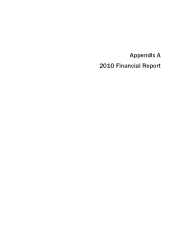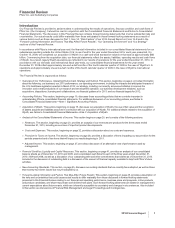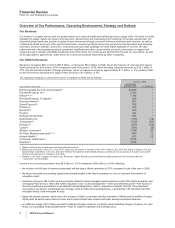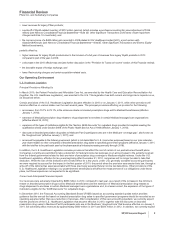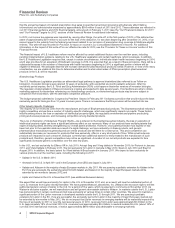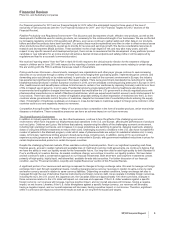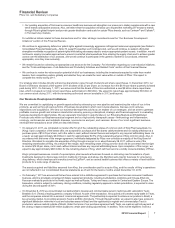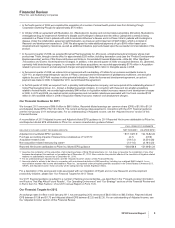Pfizer 2010 Annual Report Download - page 7
Download and view the complete annual report
Please find page 7 of the 2010 Pfizer annual report below. You can navigate through the pages in the report by either clicking on the pages listed below, or by using the keyword search tool below to find specific information within the annual report.
Financial Review
Pfizer Inc. and Subsidiary Companies
Our financial guidance for 2011 and our financial targets for 2012 reflect the anticipated impact in those years of the loss of
exclusivity of various products (see the “Our Financial Guidance for 2011” and “Our Financial Targets for 2012” sections of this
Financial Review).
Pipeline Productivity and Regulatory Environment––The discovery and development of safe, effective new products, as well as the
development of additional uses for existing products, are necessary for the continued strength of our businesses. We are confronted
by increasing regulatory scrutiny of drug safety and efficacy, even as we continue to gather safety and other data on our products,
before and after the products have been launched. Our product lines must be replenished over time in order to offset revenue losses
when products lose their exclusivity, as well as to provide for revenue and earnings growth. We devote considerable resources to
research and development (R&D) activities. These activities involve a high degree of risk and may take many years, and with
respect to any specific research and development project, there can be no assurance that the development of any particular product
candidate or new indication for an in-line product will achieve desired clinical endpoints and safety profile or will be approved by
regulators and lead to a successful commercial product.
We received “warning letters” from the FDA in April 2010 with respect to the clinical trial for Geodon for the treatment of bipolar
mania in children and in June 2010 with respect to the reporting of certain post-marketing adverse events relating to certain drugs.
We are working with the FDA to address the issues raised in those letters.
Pricing and Access Pressures––Governments, managed care organizations and other payer groups continue to seek increasing
discounts on our products through a variety of means such as leveraging their purchasing power, implementing price controls, and
demanding price cuts (directly or by rebate actions). In particular, as a result of the economic environment in Europe, the industry
has experienced significant pricing pressures in European markets. There were government-mandated price reductions for certain
biopharmaceutical products in certain European countries in 2010, and we anticipate continuing pricing pressures in Europe in 2011.
Also, health insurers and benefit plans continue to limit access to certain of our medicines by imposing formulary restrictions in favor
of the increased use of generics. In prior years, Presidential advisory groups tasked with reducing healthcare spending have
recommended and legislative changes have been proposed that would allow the U.S. government to directly negotiate prices with
pharmaceutical manufacturers on behalf of Medicare beneficiaries, which we expect would restrict access to and reimbursement for
our products. There have also been a number of legislative proposals seeking to allow importation of medicines into the U.S. from
countries whose governments control the price of medicines, despite the increased risk of counterfeit products entering the supply
chain. If importation of medicines is allowed, an increase in cross-border trade in medicines subject to foreign price controls in other
countries could occur and negatively impact our revenues.
Competition Among Branded Products––Many of our products face competition in the form of branded products, which treat similar
diseases or indications. These competitive pressures can have an adverse impact on our future revenues.
The Overall Economic Environment
In addition to industry-specific factors, we, like other businesses, continue to face the effects of the challenging economic
environment, which have impacted our biopharmaceutical operations in the U.S. and Europe, affecting the performance of products
such as Lipitor, Celebrex and Lyrica. We believe that patients, experiencing the effects of the challenging economic environment,
including high unemployment levels, and increases in co-pays sometimes are switching to generics, delaying treatments, skipping
doses or using less effective treatments to reduce their costs. Challenging economic conditions in the U.S. also have increased the
number of patients in the Medicaid program, under which sales of pharmaceuticals are subject to substantial rebates and, in many
states, to formulary restrictions limiting access to brand-name drugs, including ours. In addition, during 2010, we continued to
experience pricing pressure as a result of the economic environment in Europe, with government-mandated reductions in prices for
certain biopharmaceutical products in certain European countries.
Despite the challenging financial markets, Pfizer maintains a strong financial position. Due to our significant operating cash flows,
financial assets, access to capital markets and available lines of credit and revolving credit agreements, we continue to believe that
we have the ability to meet our liquidity needs for the foreseeable future. Our long-term debt is rated high quality by both Standard &
Poor’s and Moody’s Investors Service. As market conditions change, we continue to monitor our liquidity position. We have taken
and will continue to take a conservative approach to our financial investments. Both short-term and long-term investments consist
primarily of high-quality, highly liquid, well-diversified, available-for-sale debt securities. For further discussion of our financial
condition, see the “Financial Condition, Liquidity and Capital Resources” section of this Financial Review.
A significant portion of our revenues and earnings is exposed to changes in foreign exchange rates. We seek to manage our foreign
exchange risk in part through operational means, including managing same-currency revenues in relation to same-currency costs
and same-currency assets in relation to same-currency liabilities. Depending on market conditions, foreign exchange risk also is
managed through the use of derivative financial instruments and foreign currency debt. As we operate in multiple foreign currencies,
including the euro, the U.K. pound, the Japanese yen, the Canadian dollar and approximately 100 other currencies, changes in
those currencies relative to the U.S. dollar will impact our revenues and expenses. If the U.S. dollar weakens against a specific
foreign currency, our revenues will increase, having a positive impact, and our overall expenses will increase, having a negative
impact, on net income. Likewise, if the U.S. dollar strengthens against a specific foreign currency, our revenues will decrease,
having a negative impact, and our overall expenses will decrease, having a positive impact, on net income. Therefore, significant
shifts in currencies can impact our short-term results as well as our long-term forecasts and targets.
2010 Financial Report 5

